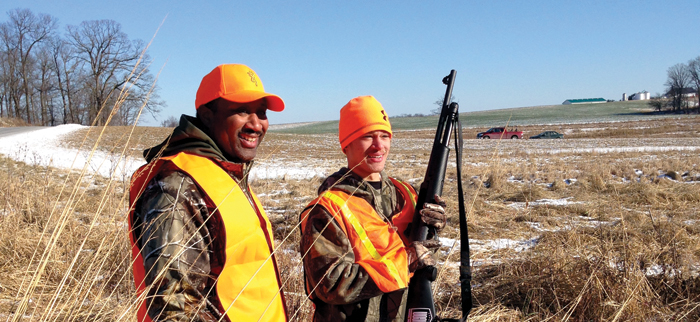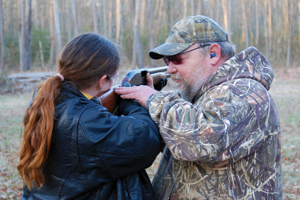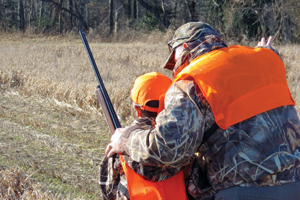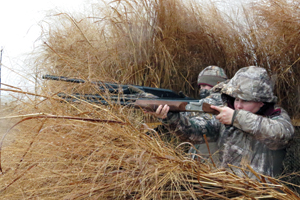A-Hunting We Will Go: New apprentice program

Camaraderie; department photos
From an ice cream shop that hands out small samples to an auto dealership that has a weekend loaner program, introductory offers have long been used to entice potential shoppers to try a product.
In order to build a relationship with an un-tapped customer base, the Maryland Department of Natural Resources is rolling out a reduced-cost hunting license for first-time hunters from any state and of any age who have never held a hunting license.

Proper instruction
The Apprentice Hunting License is $10 for residents and $20 for nonresidents, and provides the same privileges as other Maryland hunting licenses. It gives people interested in hunting a chance to try it before committing to the more lengthy process of obtaining a traditional license.
“This program is long overdue and perhaps the most meaningful step toward growing the number of life-long hunters, right here in Maryland,” says Paul Peditto, Wildlife and Heritage Service director.
A national model
The concept of novice hunting licenses was addressed by the National Assembly of Sportsmen’s Caucuses at its 2005 annual meeting, where representatives made it a legislative priority.
Wisconsin added an apprentice program in 2009, and many other states followed. As of 2016, 41 states have some type of apprentice license and more than 1.5 million such licenses have been sold nationwide, according to the Congressional Sportsmen’s Foundation. Pennsylvania, Virginia and West Virginia all offer a version of the program.
Maryland’s entrance
This year, Delegate Herb McMillan, a law-maker from Anne Arundel County and a member of the Maryland Legislative Sportsmen’s Caucus, filed the apprentice license bill.

Multi-generational bonding
A fiscal analysis of the measure concluded an apprentice license would have “a meaningful economic impact” on some businesses in the state and add $100,000 to the Wildlife Management and Protection Fund. The estimate assumed the sale of 5,000 resident apprentice hunting licenses and 2,500 nonresident apprentice hunting licenses.
“Hunters remain the primary source of revenue for wildlife conservation and are critical to the management of our deer and bear populations,” Peditto says. “Without hunters, we would have to close the doors on the business of scientifically informed wildlife management here and across the country.”
In its 2011 annual report, the U.S. Fish and Wildlife Service noted that the average hunter in Maryland spent $49 per hunting day on trip-related expenditures and $9.67 on ammunition. The report also estimated these hunters spent more than $260 million annually on equipment, food, lodging and transportation.
And hunting remains the most cost effective means to manage the state deer population and its associated problems. In 2011, the U.S. Department of Agriculture estimated that deer caused $7.7 million in crop damage statewide. The car insurance industry projected total annual damage in Maryland due to deer-vehicle collisions at $119 million.
The assessments proved compelling, and the bill, which died in 2016, was approved this year by unanimous votes of the Maryland General Assembly. Gov. Larry Hogan signed it into law, and it took effect July 1.
“Like most successful legislative initiatives, stakeholder advocates were key to moving the idea from bill to law,” Peditto explains. “Conservation, hunting and wildlife organizations worked together with the sponsors of this bill to ensure its passage.”
Allan Ellis, executive director of the Maryland Hunting Coalition and host of the Outdoorsman Radio Show, was pleased that the department has been given a proven marketing tool.
“Mentors—men and women, relatives and family friends—can now introduce a newcomer to the wholesome and exciting world of hunting with this new try-before-you-buy approach,” he says. “When vigorously promoted by the department, it should measurably enhance recruitment of new hunters into the ranks.”

Goose hunt
The specifics
A person may buy only one Maryland apprentice hunting license in their lifetime and applicants must first pass a short, online hunter safety course. Apprentice hunters must be directly supervised by a Maryland resident at least 18 years old who holds a valid Maryland non-apprentice hunting license.
While hunting, the two hunters are required to remain close enough to each other so that the mentor can take control of the firearm or bow. An apprentice hunter can hunt unaccompanied after completing the full hunter safety course and receiving a Certificate of Competency in Firearms and Hunter Safety.
Licensed apprentice hunters can hunt deer, rabbits, squirrels, turkey or waterfowl. However, appropriate stamps are needed to hunt migratory birds, waterfowl, and deer with a bow or muzzleloader. A Managed Hunt Permit is required to hunt in certain state parks for people 17 years old and older.
Article by Glenn Therres—Wildlife and Heritage associate director.
Appears in Vol. 20, No. 4 of the Maryland Natural Resource magazine, fall 2017.


 1-888-373-7888
1-888-373-7888 233733
233733